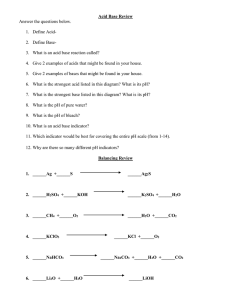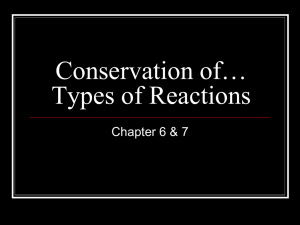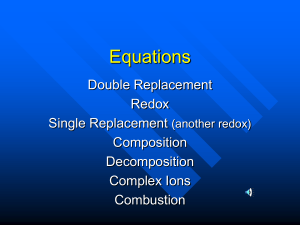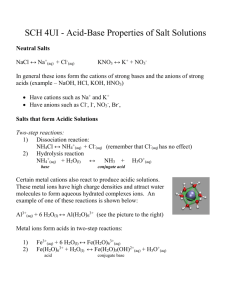AP Chemistry Page 1 of 5 Name :
advertisement
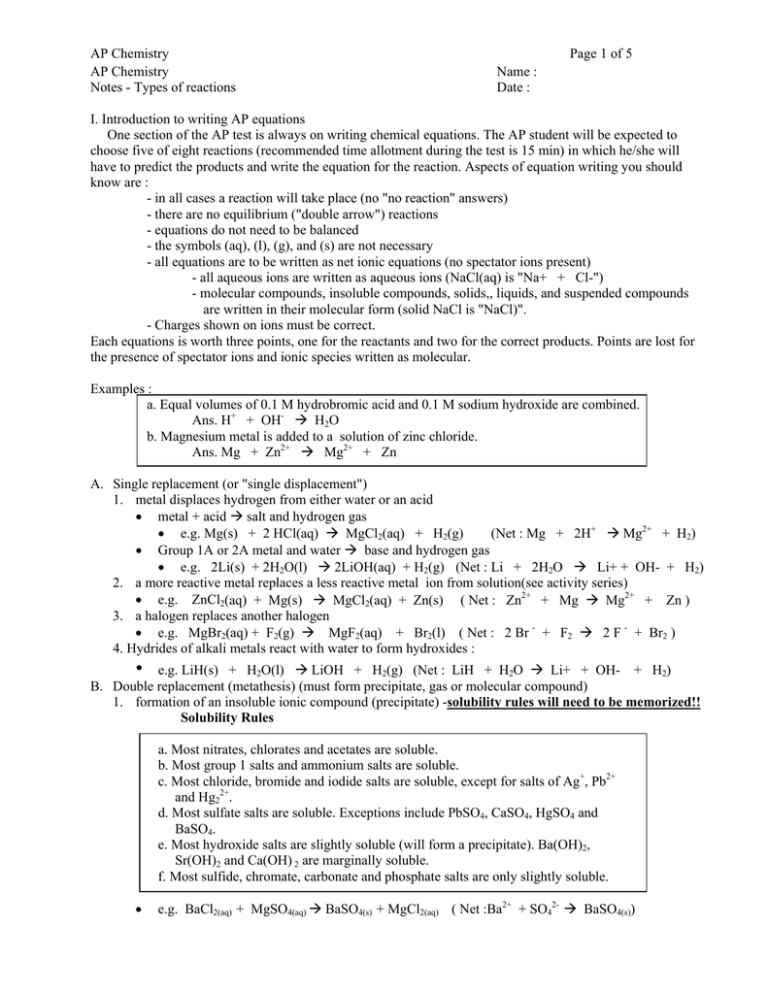
AP Chemistry AP Chemistry Notes - Types of reactions Page 1 of 5 Name : Date : I. Introduction to writing AP equations One section of the AP test is always on writing chemical equations. The AP student will be expected to choose five of eight reactions (recommended time allotment during the test is 15 min) in which he/she will have to predict the products and write the equation for the reaction. Aspects of equation writing you should know are : - in all cases a reaction will take place (no "no reaction" answers) - there are no equilibrium ("double arrow") reactions - equations do not need to be balanced - the symbols (aq), (l), (g), and (s) are not necessary - all equations are to be written as net ionic equations (no spectator ions present) - all aqueous ions are written as aqueous ions (NaCl(aq) is "Na+ + Cl-") - molecular compounds, insoluble compounds, solids,, liquids, and suspended compounds are written in their molecular form (solid NaCl is "NaCl)". - Charges shown on ions must be correct. Each equations is worth three points, one for the reactants and two for the correct products. Points are lost for the presence of spectator ions and ionic species written as molecular. Examples : a. Equal volumes of 0.1 M hydrobromic acid and 0.1 M sodium hydroxide are combined. Ans. H+ + OH- Æ H2O b. Magnesium metal is added to a solution of zinc chloride. Ans. Mg + Zn2+ Æ Mg2+ + Zn A. Single replacement (or "single displacement") 1. metal displaces hydrogen from either water or an acid • metal + acid Æ salt and hydrogen gas • e.g. Mg(s) + 2 HCl(aq) Æ MgCl2(aq) + H2(g) (Net : Mg + 2H+ Æ Mg2+ + H2) • Group 1A or 2A metal and water Æ base and hydrogen gas • e.g. 2Li(s) + 2H2O(l) Æ 2LiOH(aq) + H2(g) (Net : Li + 2H2O Æ Li+ + OH- + H2) 2. a more reactive metal replaces a less reactive metal ion from solution(see activity series) • e.g. ZnCl2(aq) + Mg(s) Æ MgCl2(aq) + Zn(s) ( Net : Zn2+ + Mg Æ Mg2+ + Zn ) 3. a halogen replaces another halogen • e.g. MgBr2(aq) + F2(g) Æ MgF2(aq) + Br2(l) ( Net : 2 Br - + F2 Æ 2 F - + Br2 ) 4. Hydrides of alkali metals react with water to form hydroxides : • e.g. LiH(s) + H2O(l) Æ LiOH + H2(g) (Net : LiH + H2O Æ Li+ + OH- + H2) B. Double replacement (metathesis) (must form precipitate, gas or molecular compound) 1. formation of an insoluble ionic compound (precipitate) -solubility rules will need to be memorized!! Solubility Rules a. Most nitrates, chlorates and acetates are soluble. b. Most group 1 salts and ammonium salts are soluble. c. Most chloride, bromide and iodide salts are soluble, except for salts of Ag+, Pb2+ and Hg22+. d. Most sulfate salts are soluble. Exceptions include PbSO4, CaSO4, HgSO4 and BaSO4. e. Most hydroxide salts are slightly soluble (will form a precipitate). Ba(OH)2, Sr(OH)2 and Ca(OH) 2 are marginally soluble. f. Most sulfide, chromate, carbonate and phosphate salts are only slightly soluble. • e.g. BaCl2(aq) + MgSO4(aq) Æ BaSO4(s) + MgCl2(aq) ( Net :Ba2+ + SO42- Æ BaSO4(s)) AP Chemistry Page 2 of 5 2. neutralization reaction between an acid and a base (forms water) Common a. strong acid/strong base : gases : • e.g. HCl + NaOH Æ H2O + NaCl (net : H+ + OH- Æ H2O) H2S b. strong acid/weak base CO2 • e.g. HCl + NH3 Æ NH4Cl (net : H+ + NH3 Æ NH4+) SO2 • e.g. HCl + CH3NH2 Æ CH3NH3Cl (net : H+ + CH3NH2 Æ CH3NH3+) NH3 c. weak acid/strong base • e.g. HC2H3O2 + NaOH Æ H2O + C2H3O2- (net : HC2H3O2 + OH- Æ H2O + C2H3O2-) 3. reactions with acids : • carbonates or bicarbonates and acids form a salt, water and CO2 • e.g. 2HCl + Na2CO3 Æ 2 NaCl + H2O + CO2 (net : H+ + CO32- Æ H2O + CO2) • sulfites and acids form a salt, water and SO2 • e.g. 2 HCl + Na2SO3 Æ 2 NaCl + H2O + SO2 (net : H+ + SO32- Æ H2O + SO2) • metallic sulfides and acids form H2S and a salt • e.g. 2 HCl(aq) + Na2S(aq) Æ 2 NaCl(aq) + H2S(g) (net : H+ + S2- Æ H2S ) • metallic hydrides and acids form H2 and a salt • e.g. HCl(aq) + LiH(aq) Æ LiCl(aq) + H2(g) (net : H+ + H+ Æ H2) 4. strong acids with salts of weak acids (salts containing anions such as : OCl-, ClO2-, F-, NO2-, CN-, C2H3O2-) • e.g. metallic acetates and acids form acetic acid and a salt • e.g. HCl(aq) + NaC2H3O2(aq) Æ NaCl(aq) + HC2H3O2(aq) (net : H+ + C2H3O2- Æ HC2H3O2) • e.g. metallic nitrites and acids form nitrous acid and a salt • e.g. HCl(aq) + NaNO2(aq) Æ HNO2(aq) + NaCl(aq) (net : H+ + NO2- Æ HNO2) 5. reactions with bases : • ammonium salts and soluble bases yield ammonia, water and a salt • e.g. NH4Cl + LiOH Æ NH3 + H2O + LiCl (net : NH4+ + OH- Æ NH3 + H2O) C. Combination 1. metal and nonmetal form a binary ionic compound • e.g. 2 Na + F2 Æ 2 NaF 2. two nonmetals form a binary covalent compound • e.g. S + F2 Æ SF2 3. metal or nonmetal combines with oxygen to form binary ionic or covalent compound • e.g. 2 Mg + O2 Æ 2 MgO 4. nonmetallic element combines with a binary covalent compound • e.g. oxygen and nonmetallic oxide (sulfur dioxide + oxygen Æ sulfur trioxide) • e.g. nonmetallic halide and additional halogen ( chlorine trifluoride and fluorine Æ chlorine tetrafluoride) 5. Combination of two compounds • metallic oxide and nonmetallic oxide form an ionic compound with a polyatomic ion • e.g. Na2O + CO2 Æ Na2CO3 • metal oxides react with water to form hydroxides • e.g. CaO + H2O Æ Ca(OH)2 • nonmetal oxides react with water to form acids • e.g. SO2 + H2O Æ H2SO3 (net : SO2 + H2O Æ H+ + HSO3-) • hydrates result when anhydrous compounds react with water to form hydrates • e.g. CuSO4 + 5 H2O Æ CuSO4·5H2O AP Chemistry D. Decomposition 1. thermal decomposition • carbonates yield oxides and carbon dioxide • e.g. CaCO3 Æ CaO + CO2 • sulfites yield oxides and sulfur dioxide • e.g. FeSO3 Æ FeO + SO2 • oxides, chlorates and perchlorates yield oxygen • e.g. 2HgO Æ Hg + O2 • e.g. 2KClO3 Æ 2KCl + 3O2 • e.g. NaClO4 Æ NaCl + 2O2 • hydroxides, hydrates and some oxyacids release water • e.g. Ca(OH)2 Æ CaO + H2O • e.g. CuSO4-5H2O Æ CuSO4 + 5 H2O • e.g. H2SO3 Æ H2O + SO2 2. Electrolysis - use of electricity to decompose compounds • e.g. 2 NaCl Æ 2 Na + Cl2 E. Combustion of hydrocarbons produces water and carbon dioxide • e.g. 2 C6H14 + 19 O2 Æ 14 H2O + 12 CO2 Page 3 of 5 F. Redox reactions - involve a transfer of electrons (something is oxidized and something else is reduced) and a change of oxidation state. Single replacement and combustion reactions are always redox reactions. Combination and decomposition reactions are sometimes redox reactions. If a reaction takes place in an acidic or basic solution it is most likely a redox reaction. Reactions involving elements in their natural states (e.g. Al, Fe, Cl2, O2, etc.) are redox reactions. 1. Simple redox reactions : a. Hydrogen displacement • e.g. Ca(s) + H2O Æ Ca(OH)2(aq) + H2(g) b. Metal displacement • e.g. Zn(s) + CuCl2(aq) Æ ZnCl2(aq) + Cu(s) (Net : Zn + Cu2+ Æ Zn2+ + Cu) c. Halogen displacement • e.g. Cl2(g) + MgBr2(aq) Æ MgCl2(aq) + Br2(l) (Net : Cl2 + Br- Æ Cl- + Br2) d. Combustion reactions (see above) e. Combination and decomposition reactions (see above) 2. Reactions involving transition metals with multiple oxidation states : • e.g. tin(II) ion with Fe(III) ion (net : Sn2+ + Fe3+ Æ Sn4+ 3. Free halogens in dilute basic solutions form hypohalite ions + Fe2+) • e.g. Cl2(g) + KOH(aq) Æ KClO(aq) + KCl(aq) + H2O(l) (Net : Cl2 + OH- Æ ClO- + Cl- + H2O) 4. Redox reactions involving oxyanions such as Cr2O72• e.g. 14H+(aq) + Cr2O72-(aq) + 6Fe2+(aq) Æ 2Cr3+(aq) + 7 H2O(l) + 6Fe3+ The only way to be able to predict these types of reactions is to become with familiar (i.e. memorize) common oxidizing and reducing agents. See table below. Common Reducing Agents Halide ions Free metals Sulfite ions or SO2 Nitrite ion Free halogens (dilute basic solution) Free halogens (concentrated basic solution) Metallous ions (lower oxidation number) Products formed Free halogen Metal ions Sulfate ions Nitrate ion Hypohalite ions Halate ions Metallic ions (higher oxidation number) AP Chemistry Common Oxidizing Agents MnO4- (acidic solution) MnO2 (acidic solution) MnO4- (neutral or basic) Cr2O72- (acidic solution) HNO3 (concentrated) HNO3 (dilute) H2SO4 (hot, concentrated) Metallic ions (high oxidation number) Free halogens Na2O2 HClO4 C2O42H2O2 Page 4 of 5 Products formed Mn2+ Mn2+ MnO2(s) Cr3+ NO2(g) NO(g) SO2(g) Metallous ions (lower oxidation number) Halide ions NaOH ClCO2(g) O2(g) G. Organic reactions 1. Oxidation (combustion reactions) (See E. above) 2. Substitution reactions by halogens • e.g. butane and bromine : C4H10 + Br2 Æ C4H9Br + HBr 3. Esterification - organic acid and alcohol forms an ester and water • e.g. acetic acid and ethanol : CH3COOH + C2H5OH Æ CH3COOC2H5 + H2O 4. Addition : A C=C bond is broken and atoms are attached to the carbon atoms • • e.g. butene and hydrogen gas form butane : C4H8 + H2 Æ C4H10 e.g. hexene and bromine : C6H12 + Br2 Æ C6H12Br2 H. Complexation reactions (coordination chemistry) : (look for terms "excess" or "concentrated") These reactions usually involve transition metal ions bonding to ligands (Lewis bases - electron pair donors) to form complex ions. E.g. Cr(H2O)63+, where the transition metal ion is the Cr3+ ions and the 6 water molecules are the ligands. They are bonded by a coordinate covalent bond which is formed by the sharing of the electron pairs donated by the water molecules. Common ligands and their names : Ligand H2O NH3 ClFBrICNOHNO3NO2O2SO42CH3NH2 (CH3)2NH NO CO Examples of cations : [Cr(H2O)6]3+ - hexaaquochromium(III) [Cu(NH3) ]2+ - tetraamminecopper Name aquo ammine chloro fluoro bromo iodo cyano hydroxo nitrato nitro oxo sulfatomethylamine dimethylamine nitrosyl carbonyl AP Chemistry Page 5 of 5 + [Ag(NH3) ] - diamminesilver [Cr(NH3)5(H2O) ]3+ - pentammineaquochromium(III) Examples of anions : [Cr(H2O)2Cl4]- - diaquotetrachlorochromate(III)* [GaCl3(OH)]- - trichlorohydroxogallate(III) - tetrahydroxoaluminate [Al(OH)4]Examples of compounds : Na[Al(OH)4] sodium tetrahydroxoaluminate *ligands are arranged alphabetically (aquo before chloro) - ligands are named before the metal ion The number of ligands attached to a central metal ion is called the coordination number. e.g. Cr(H2O)63+ has a coordination number of 6. Two, four and six are the most common coordination numbers. The coordination number is often twice the oxidation number of the metallic ion. Ligands are joined one at a time and have a formation constant for each reaction that joins a single ligand. This means that it would take six reactions to form Cr(H2O)63+, each successive reaction joining another water molecule. Likewise, each step would have its own formation constant. ♦ Al2O3 + OH- Æ [Al(OH)4]♦ NH3 + Zn2+ Æ [Zn(NH3)4]2+ ♦ Fe2+ + SCN- Æ [FeSCN] 2+ Keys to success in equation writing on the AP test : 1. 2. 3. 4. know ion formulas and charges know solubility rules know common oxidizing agents Identify reaction type - remember to add H+ and water to balance redox reactions (watch for term "acidified" indicates redox rxn) - free elements indicate redox reactions 5. Remember amphoteric substances Zn2+ and Al3+ form hydroxides that dissolve in both acids and bases. 6. Leave out spectator ions AP Test instructions : "Use appropriate ionic and molecular formulas to show the reactants and the products for the following, each of which occurs in aqueous solution except as indicated. Omit formulas for any ionic or molecular species that do not take part in the reaction. You need not balance. In all cases a reaction occurs." The following website is designed to help you learn the various types of reactions. I highly recommend it. It is challenging and you may be learning by "trial and error" (especially with redox reactions - an emphasis of AP equations) at first, but you will catch on. http://dwb.unl.edu/Chemistry/Desc/Start2.html (login with something like first@timer)



